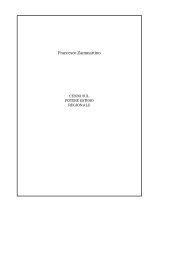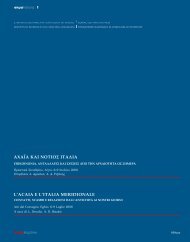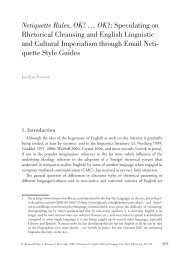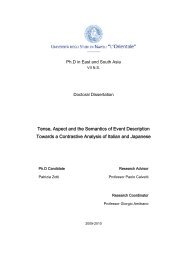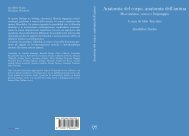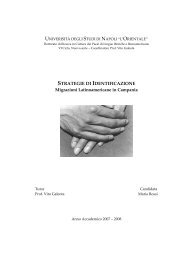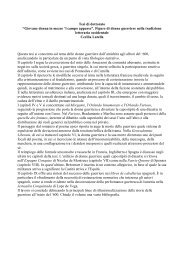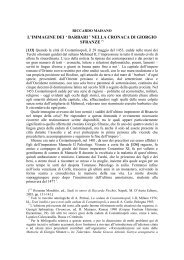You also want an ePaper? Increase the reach of your titles
YUMPU automatically turns print PDFs into web optimized ePapers that Google loves.
secsa1\- reness of the- e XIX'h century1:=:c:::z:lCe of this exererunderesti-• oung" disci-- .. uting to theopia sinceO:::....:~, ,~ exploitation of• "=-' er, today theL "- -':: o" disciplinestarting froml'i-::'ì ,-vy'"""ction - has~eI:::=:;:Jle of applica-- tory: theconternpo--erify the hy-,""",~'':~ _ _behà and tot: - e ideology)Philology and the Reconstruction of the Ethiopian Past 9332): near the actual Foqàdà, in Dahànè C'Agame)5 among ruins of important buildings,the remnants of an Aksumite church stand out." Sometimes the possibility has beenalleged that certa in traditions were invented to justify the presence of archaeologicalruins appearing mysterious to the eyes of the local people, as the result of the impressionthey made on the "narve" Ethiopian minds. This kind of explanations treats thewritten sources like the oral traditions, which different communities elaborated inorder to interpret the presence on their territory of ancient ruins of undetermined pastages.' Though this can sometimes be true, yet in our case other elements should bealso taken into account.First, the supposed a posteriori attribution of certain ruins to the age of theAksumite saints requires in any case the existence of the traditions related to the missionariescoming from Rom, i.e. the Byzantine Empire. In other words, the problem issimply postponed, and the origins of the legend, recorded by many sources datingback to different times, would continue to ask for an explanation. Second, in Ethiopiathere exists an unbroken tradition of recording historical memories, gathered andwritten down inside churches and monasteries (Lusini 2001a). It is on this culturalchain that the perception of the past - and of its distance - relies, and the Aksumite"origins" are often present in the XIV1h_XV 1h c. Ethiopian literature, particular1y in thechronographical texts." The royallists (Conti Rossini 1909), for instance, and the monasticgenealogìes,? in spite of their obvious deficiencies, express the ne ed of fillingup the documentary gaps, which the learned men were forced to remedy time aftertime by silence or by invention. Third, the Aksumite literary heritage transmitted tothe medieval times is in no way neglìgìble'" and the radical scepticism toward thereliability of the hagiografic traditions doesn't take into account the possibility, insome cases already proved, that certain texts could have been written again or updatedseveral centuries after their first draft." Likewise, the iconological study of theexhibitedin5 On the site see Godet 1977: 37 and 47 (without registration ofthe Christian ruins),6 Described in Conti Rossini 1925: 484-489 (29. Le rovine di Dahané); Bausi 1999: 18 (note25) and 24.7 As in the case, for instance, of the Aràtu ruins, May Awalid valley, in the 'Ansabà basin (Karan,Eritrea). One can see there a monumental podium with stairs, called by the local peopie"the angareb of Sarnaraééon", with reference to the traditional genealogies: Piva 1907;Dainelli - Marinelli 1912: 525-527; Godet 1980-82: 81-82.8 On this specialliterature see particularly the works of Otto Neugebauer: 1979; 1979a; 1981;1982; 1983; 1988; 1989. For a recent edition of one of the most important texts see GetatchewHaile 2000.9 Getatchew Haile 1982-83; 1992; Lusini, forthcoming.lO Among the more recent studies see Bausi 1998, and Voicu 1998: 19-23.11 Starting from the meaningful case of the Old Testament: see now Knibb 1999. The Acts 0/Mark: Getatchew Haile 1981. The AncoratusofEpiphanius: Proverbio 1997. In the samesense one can interpret the text coincidences between the dedicatory inscription engravedby order of king Làlibalà (about 1186-1225) on the manbara tabotofthe Golgotà church, in(continued ...)
94 Gianfrancesco Lusiniillustrated cycles of the medieval Ethiopian manuscripts, with their proved connectionto the early Bizantine patterns, not unknown in the yth_VII 1h c. Aksum, is anothersign of the capability of the Ethiopian tradition to transmit ancient elements for centurìes."In one case at least the evidences lead to contradict the more radical manifestationsof scepticism. This is the case with a monastic centre and the related documents,both considered ancient by the ecclesìastìcal tradition and actually tracing back to aperiod preceding the XJV'h_XV 1h c. Among the land charters gathered in the GoldenGospel of Dabra Libànos, no. 7 13 contains the text of a land grant, donated (wahabku)by king Làlibalà (about 1186-1225) to the Eritrean monastery (laMara' za'Absm). Thetext is dated 1225 and there is !ittle doubt about its authenticity. The title badsniisusau, imitating that of the Aksumite inscription of Dàri'él (VIII 1h IIX 1h c.), the rayalformula be'esi 'azal za'iyetmaunoè 'ladar, repraducing the one used by the kings ofAksum, the technicai verb aksamku describing the deed's pramulgation (cp. thewords zentu kesum below in the same text), with a possible etymoiogicai referenceto the name of the city of Aksum ìtself" - all these elements Iet one believe the documentand its datation true. Consequently, it testifies not only that Dabra Lìbànos alreadyexisted in the XII1h/XIIIlhc., but aiso that the high prestige of the convent wasacknowledged by the king. Thanks to these elements, one can admit that the Ge'eztexts related to the appearance of Christianity in Ethiopia were drawn up using orai orwritten sources which, among the inventions of the literary genre, had preserved thememory of ancient facts. The identification of those facts remains the responsibility ofthe researchers.If manuscripts of hagiographic texts older than XJV'hc. are not known this is owedto the simple fact that the finai composition of the gadlat is recent. In fact, thanks aisoto the recovery of the traditions pivoting on the Aksumite saints, an officiai version ofthe events related to the Christianization of Ethiopia was imposed in the XJV'h_XV'hc.,serving the politicai and religious ambitions of the kings. The result was, in a way, anattempt of philological reconstruction, based on the Kebra nagast and having as a11 c.. .continued)the capital of the ZagWe kingdom (Gigar Tesfaye 1984), and the homily Ba'enta sanbatst,written by the Ethiopian metropolite or by another authoritative clergyman in the first halfofXIV c. (Lusini 1993: 130-175). The list of the corresponding passages is the following:Lusini 1993: 132,11. 13-15 = Gigar Tesfaye 1984: 115 (side l, 11.1-2); Lusini 1993: 144, 11.19-20 = Gigar Tesfaye 1984: 115 (side 2, Il. 3-4); Lusini 1993: 154, li. 14 - 156, li. 6 = Gigar Tesfaye1984: 115 (side 2, li. 12) - 116 (side 2, li. 16). Since the two texts cannot be interdependent,one must admit that they separately exploited an ancient source, like a canonicalcollection similar to the Sènodos, apparently already existing in the Aksumite age, see Lusini2001: 556-557.12 For some case studies see Fiaccadori 1993 and 1995, and the analysis in Balicka-Witakowska 1997.13 Conti Rossini 1901: 189-192; see also Bausi 1997: 13-23.14 Ricci 1994: 188-190; for a different hypothesis see Mi.iller1998.(I
)Philology and the Reconstruction of the Ethiopian Past 95target the establishment of a fundamental thesis: the political alliance and the commoneschatological destiny of the Byzantine emperor and the Aksumite king. Theorigins of these politica l and religious beliefs are ancient, but it was in the years betweenthe 1270 turning point and the reign of Zar'a Yà'qob 0434-1468) that theyprovoked the composition of such texts as the Fekkare Iyasus and the Rs'eya Senute,describing the decisive role to be played by the Ethiopian king at the end of times(Conti Rossini 1899: 216; Fiaccadori 1992: 80-81).• • •- _ • sanbatst,ldi:~r=~-.::: e fìrst halffollowing:: 44, LI.19-= GigarTes-. erdepenecanonica!~ J!~.:=~ _ , see Lusini:r..;:~'Sis in Balicka-An emblematic case is the story of Abrehà and Asbehà, the mythical couple of brotherswhom the tradition - refreshing the memory of the IV'h c. Kings 'Ezana andSà'ezànà - claims credit for having promoted the introduction of Christianity into theKingdom of Aksum. The origins of the legend, starting from the association of twopersonalities of the same age, have been reconstructed since long time. Asbehà isKàléb/Ella Asbehà, son and successor of Tàzénà at the end of V'h C., the king who,about 525, imposed the politica l authority of Aksum on both sides of the Red Sea(Brakmann 1994: 81-96). Abrehà is the name of the Christian leader, of Ethiopianorigin, ruling over South Arabia a few years after Kàléb's victory on the king ofHìmyar, Yùsuf As'ar Yaj'ar, called Qu Nuwàs, and the temporary unification of thetwo kingdoms (Conti Rossini 1928: 259). In this case, too, the myth seems to containthe re-elaboration of ancient facts transmitted in some way up to xrvvxv' c.A passage in the Mashafa Aksum ascribes the foundation of the Màryàrn Seyonchurch" to Abrehà and Asbeha, an element which deserves our attention. As a wellknowntradition claims, Aksum is the "rnother of the Ethiopian towns" (temmonla 'abgura 'ityoftya) - both because of its antiquity and because of the presence of themain sanctuary of the Ethiopian Christianity in it, the gabaza 'aksum (Littrnann -Krencker 1906: 3; Lensi 1937). The archaeological evidence confirms that the cathedraltraces back to an old date," probably to the years of Kaleb, as one can supposeon the basis of different indications. First, the historical situation of the first half of theVI th c. has to be considered. It was dominated by the economie and political conflictbetween the pro-Byzantine Ethiopia and the pro-Sassanian Yemen for the control ofthe trade routes along and around the Red Sea (Harmatta 1974; Loundine 1974), andby the ideological and religious confrontation between the two monotheistic cornmunities,both claiming to be the Verus lsraèl. The annexation of Himyar completes thepicture, and provides a valid context for the construction of a big Christian Tempie inAksum. Its foundation would then be tied to the military victory of the Ethiopian15 Conti Rossini 1909-10: 3 (text) and 3 (transl.)16 Krencker 1913: 136-140; Monneret de Villard 1938: 21-31; Contenson 1963: 3-14; Munro-Hay 1991: 209; Phillipson 1997: 114-116; Munro-Hay 2002: 308-315 (History of the Cathedralof Maryam Seyon),
)Philology and the Reconstruction of the Ethiopian Past 97ment appears," reflected in the names of Israèl (550 ca.), Gersem (580 ca.) Hataz (590ca.) and Iòèl (600 ca.), whose relationship with episodes of the history of Israel iscertaìn." Apparently, the establishment of the Christian faith, rooted in the Old Testamentand at the same time strongly anti-Judaic, arose from the anti-Hìmyarite politicaland military strategy. In other words, the dissolution of the economie and religiousrival and the unification of the two kingdoms supported the elaboration of an ideologicaldisplay based upon the transfer of the holiness and symbolical1y expressed bythe foundation of the new Temple of the VerusIsraèl, Le. the cathedral of Aksum. Inthis sense another evidence is instructive, namely a passage from the Book oftheHirnyarites, ch. 48 (= fragm. XXVII"), in which Kaleb, after his victory on Du Nuwàs, issaid to have brought many prisoners and fifty princes of the South-Arabian royalhouse" with him. The chance that this transfer of members of the Yemenite Jewisharistocracy actually took place should not be ruled out, and in any case the Syriac textseems to contain a reference to a strategy of political and religious integrationbrought forward by the Aksumite king. The Kebra nagast, too, after all, talking aboutthe transfer of the Ark, makes use of a similar literary device, when it narrates ofBayna Lehekern's arrìval in Ethiopia - together with the first-borns of the main Israelitefamilies.As a part of the same process, in the years following the rnilitary conflict withHìmyar the Ethiopian religious culture, though keeping a constant "Christian" polemicsagainst the people guilty of deicide, acquired an ever stronger Judaic mark, noticedby external observers at least from the XI'h c. (Taddesse Tamrat 1972: 209; Lusini1993: 27). These "Judaic" features of the Ethiopian Christianity have been often attributedto old and obscure religious eontacts with jewìsh communities or mìssìons."More likely, we are dealing with a phenomenon described in socìology: an externalconfliet ean give rise to new manifestations of ethnicity inside a communìty;" in ourcase in the form of a conscious imitatio Veteris Testamenti." In this eontext, thefounding myth of the Ethiopian kingship, related in its official form by the Kebranagast;" reeeives an explanation more plausible than the commonly accepted theories,aeeording to which the story would express unlikely collective memories of~~stiontraces backP'==:::t:~uyevìdence, the22 Marrassini1994:206;1995:8; Hahn 2001:124-128;Hahn - Kropp 2000.23 See Ioshua 15,13-19(Kaleb),Genesis 35,10(Israél),Exodus2,22(Gersern), 1Chronicles4,13(I:Iataz),Nehemia 11,9(IDeI).24 Moberg 1924:56a, Il. 17-18(text), p. CXLn (translatìon),Shahid 1963.25 Ullendorff 1956; 1968: 73-115; Hammerschmidt 1965; Pawlikowski 1971-72;Isaac 1972;1973.26 Smith 1981;1992:95-101.An applicationofthese principles to the state building process inEthiopiaand Eriythreaìs in Clapham2000.27 Accordingto the principles effectivelyapplied in the articles by MaximeRodinson: 1963;1964;1964a; 1965;1972.See also Marrassini1987b,and Lusini1993:27-31.28 In fact, the oral tradition transmittedancient and important versìonsof the legend, differentfromthe one exploited in the Kebra nagast, see Littmann1904:13-40.
98 Gianfrancesco LusiniEthiopian past dominated by indefinite jewish (Solomon) and South-Arabian (theQueen of Sheba) presences. Accordingly, the capital city of the Ethiopian State receivedthe religious attributes of a "New jerusalem", among which the centrai piacewas occupied by the foundation of the cathedral, intentionaIIy imitating the church ofthe Holy Sepulchre, or inspired by the pIan of a Constantinian basilica (HeIdman1993; 1992: 227). Probably the mode I Iying under the simultaneous celebration ofboth the capital and its king derives from the contacts between Aksum and Byzantium,as the same is characteristic for a cornplex of traditions connected to the Romanemperors (Cerulli 1974; Marrassini 1983). In fact, the VIth_VlI th conflicts with Persiansand Arabs about the defence and the consolidation of the eastern borders of the Empireprovided an occasion for the development of two interreiated irnages: Constantinopleas the "New Zion" and the emperor as an earthly figure of the heavenly~acrtÀ.Eùç, both destined to last for severai centuries (PatIagean 1994: 459-461; 1998).The "Byzantine" modei allowed the Ethiopian king to face the more severe criticismpronounced against his earthIy functions (Lusini 2001a), as those exhibited in theSbepberd of Herrnas" or in the Antichrist of Hyppolìtus'", so that he couId begin toclairn for himself the immanent role of defender of the faith (Marrassini 1993: 22-39)and the eschatological function of guide of alI the Christians till the end of times(Lusini 1999b). Apparently, the terminus ante quem of this sacralization of the highestEthiopian authority seems to be provided by the two inscriptions of the hadsniDàn'él, the Iord of Aksum who, in the vnr' or JXh c., defined hìmself as a member ofa monastery near the capitai (walda dabra feremJY The most ancient evidence of thefulfilled process is in Abù Sàlìh, the Arab writer of Armenian origin who, reporting theinformation obtained by traveIIers between the end of the xn" c. and the beginningof the XIII th c., retoId the legend of Solornon and the Queen of Sheba and celebratedEthiopia not onIy as the land pretending to own the Ark of the Covenant, but aisobecause this Country was ruied by kings devoted to religious life (Evetts 1969: 284-288; Marrassini 1994: 206).Bibliograp .29 Abbadie 1860; Dillmann 1861; Beylot 1988; Raineri 1993; Piovanelli 1994: 329-330; 1993:197-199; Lusini 1999a; 200lc. Greek Text: Kòrtner - Leutzsch 1998: 105-497.30 Greek Text: Norelli 1987. Ethiopic version: Caquot 1965; Beylot 1991.31 Littmann 1913b: nos. 12 and 13 = Bernand et al. 1991: nos. 193 l-TI; Fiaccadori 1996: 327-328(Il. Dabra Ferèm).(
)BibliographyPhilology and the Reconstruction of the Ethiopian Past 99Abbadie, A. d'1860 Hermae Pastor. Abhandlungen fii.r die Kunde des Morgenlandes 2: 1-110(text) and 113-182 (transl.),Balicka-Witakowska, E.1997 La Crucifixion sans Crucifié dans l'art étbiopien. Recherches sur la survie del'iconograpbie chrétienne de l'Anttquité tardive. Bibliotheca nubica etaethiopica 4. Warszawa.Bausi, A.1997 Su alcuni manoscritti presso comunità monastiche dell'Eritrea, III. Rassegnadi studi etiopici 41: 13-55.1998 L'Epistola 70 di Cipriano di Cartagine. Aetbiopica 1: 101-130.1999 Appunti sul Gadla Libànos, Warszawskie Studia Teologiczne 12 (MiscellaneaAethiopica S. Kur oblata): 11-30.Bernand, E., Drewes, A. J. and Schneider, R.1991 Recueil des inscriptions de l'Étbiopie des périodes pré-axoumite et axoumite,introd. de Francis Anfray, I. Les documents. Paris.Beylot, R.1988 Herrnas. le Pasteur. Quelques variantes inédites de la version éthiopienne. In:Mélanges A. Guillaumont. Cahiers d'Orientalisme 20. Genève: 155-162.1991 Hippolyte de Rome, Traité de l'Antéchrist, traduit de l'éthìopìen. Semitica 40:107-139.Brakmann, H.1994 TO nAPA TOIC BAPBAPOIC EPrON eEION. Die Einwurzelung der Kircheirn spàtantileen Reicb von Aksum. Bonn.Caquot, A.1965 Une version ge'ez du traité d'Hìppolyte de Rome sur l'Antichrist. Annalesd'Etbiopie 6: 165-214.329-330; 1993:Cerulli, E.1949 Carlo Conti Rossini. Oriente Moderno 29: 93-102.1974 Gli imperatori Onorio ed Arcadio nella tradizione etiopica. In: IV CongressoInternazionale di Studi Etiopici. Roma: 15-54.1fu:::::!c:)OO' 1996: 327-328
100 Gianfrancesco LusiniClapham, C.2000 Guerra e fomazione dello stato in Etiopia e Eritrea. Africbe e Orienti lI, 3/4:110-118.Contenson, H. de1963 Les fouilles à Axoum en 1958. Rapport préliminaire. Annales d'Eibiopie 5: 3-16.Conti Rossini, C.1895 Appunti ed osservazioni sui re Zàgué e Takla Hàyrnànot. Reale Accademiadei Lincei. Rendiconti, ser. V;IV: 341-359 and 444-468.1899 Note per la storia letteraria abissina. Reale Accademia dei Lincei. Rendiconti,ser. V; VIII-197-220.1901 L'Evangelo d'oro di Dabra Libànos. Reale Accademia dei Lincei. Rendiconti,ser. V;X: 177-219.1903 Ricordi di un soggiorno in Eritrea. Asmara: 25-41.1909 Les listes des Rois d'Axoum.]oumaIAsiatique, ser. X, XIV: 263-320.1909-10 Documenta ad illustrandam bistoriam I. Liber Axumae, CSCO 54. Aeth 24,CSCO 58. Aeth 27.1921-23 Aethiopica. Rivista di studi orientali 9: 365-381 ançl449-468.1922 La caduta della dinastia Zagué e la versione amarica del Be'ela Nagast. RealeAccademia dei Lincei. Rendiconti, ser. V;XXXI: 279-314.1925 Aethiopica (Il" serie). Rivista di studi orientali lO: 469-520.1928 Storia d'Etiopia, 1. Dalle origini all'avvento della dinastia salomonide.Bergamo.Dainelli, G. and Marinelli, O.1912 Risultati scientifici di un viaggio nella Colonia Eritrea. Firenze.Dillmann, A.1861 Bemerkungen zu dem athìopìschen Pastor Hermae. Zeitscbrift der DeutschenMorgenlàndiscben Gesellschajt 15: 111-125.Drewes, A. J.1978 Kaleb and Himyar: another reference to HYWN'?Raydan 1: 27-32.Evetts, B. T. A.1969 The churches & monasteries 0/Egypt and some neighbouring countries attributedto Aba Sdlib, the Armenian. 2 nd ed., Oxford.Fiaccadori, G.1992 TeofiloIndiano. Ravenna.
Philology and the Reconstruction of the Ethiopian Past 101~- e Orienti Il, 3/4:~::.::!:'Sd'Étbiopie 5: 3-------,,)993 Bisanzio e il regno di 'Aksum. Sul manoscritto Martini etiop. 5 dellaBiblioteca Forteguerriana di Pistoia, in Quaecumque recepit ApoUo. Scritti inonore di Angelo Ciavarella, a c. di Andrea Gatti, Bollettino del MuseoBodonianodiParma 7: 161-199.1994 Prototipi miniati dell'Ottateuco etiopico. Bollettino del Museo Bodoniano diParma 8: 69-102.1996 Epigraphica Aethiopica. Quaderni Utinensi 8: 325-333.Getatchew Haile1981 A new Ethiopic version of the Acts of St. Mark (EMML 1763, ff. 224'-227').Analecta Bollandiana 99: 117-134.1982-83 The Monastic genealogy of the line of Takla Haymanot of Shoa. Rassegna distudi etbiopici 29: 7-38.1992 A fragment of the Monastic Pathers of the Ethiopian Church. In: P.O. Scbolz,R. Pankburst and W. Witakowski (eds.), Orbis Aetbiopicus. Studia in bonoremStanislaus Cbojnacki natali septuagesimo quinto dicata, septuagesirnoseptimo oblata, 1.Bibliotheca Nubica, 3. Albstadt: 231-237.2000 Bsbra Hassib. Collegeville, Minnesota.- = - -agast. RealeGigar Tesfaye1984 Inscriptions sur bois de trois églises de Lalibela. [ournal oj Btbioptan Studies17'107-126.;:5::;z:;;jQ' salomonide. Godet, E.1977 Répertoire de sites pre-axoumites et axoumites du Tigré (Ethiopie). Abbay 8:19-58.1980-82 Répertoire des sites pré-axoumites et axoumites de l'Ethiopie du Nord II.Erythrée. Abbay 11: 73-113.~±~.-'O der DeutscbenHahn, W.2001 Noe, Israel und andere Konige mit biblischen Namen aufaxumitischenMunzen. Der Gottesbund als Legitimation der christlichen Kònigsherrschaftim alten Athìopien. Money Trend XlI, 12: 123-128.I"T-_",,",countries attrib-Hahn, W. and Kropp, M.2000 The biblical names ofAxumite kings as attested on their coins as indicationfor a political program based on the AT. Paper presented at the:x:rv h InternationalConference of Ethiopian Studies. (Addis Ababa, 2000)Hammerschmidt, E.1965 jewish elements in the cult of Ethiopian Church. [ournal oj Etbiopian Studies3: 1-12.
102 Gianfrancesco LusiniHarrnatta, J.1974 The struggle for the possession of South Arabia between Aksùm and theSàsànians. In: IV Congresso Internazionale di Studi Etiopici. Roma: 95-106.Heldman, M.E.1992 Architectural symbolism, sacred geography and the Ethiopian Church. fournalof the Religions in Africa 22: 222-241.1993 Maryam Seyon: Mary of Zion. In: R. Grierson (ed.), African Sion. Tbe sacredart of Etbiopia, New Haven - London: 71-75.Isaac, E.1972 An obscure component in Ethiopian Church history. An examination of varioustheories pertaining to the problem of the origin and nature of Ethiopianchristianity. LeMuséon 85: 225-258.1973 A new text-cruical introduction to Mashafa Berbèn, with a translation cf bookI. Leiden.Knibb, M.A.1999 Translating the Bible, Tbe Etbiopic version ofthe Old Testament. Oxford._ :a"Kòrtner, D.H.J. and Leutzsch, M. (eds.)1989 Papiasfragmente. Hirt des Hermas. Darmstadt.Krencker, D.1913 Deutsche Axum Expedition II. Altere Denkmaler aus Abessiniens. Berlin.Lensi, G.c.1937 Acsum, città santa. In: Atti del Terzo Congresso di Studi Coloniali, IV (IllSezione: storica arcbeologica), Firenze: 151-161.Littmann, E.1904 The legend ofthe Queen of Sheba in the tradition of Axum. Leyden - Princeton,New]ersey.1913a Deutsche Axum Expedition I. Reisebericbt der Expedition. Topograpbie undGeschichte Aksums. Berlin.1913b Deutsche Axum-Expedition IV. Sabàiscbe, Griecbiscbe und AltabessinischeInschriften. Berlin.Littmann, E. and Krencker, D.1906 Vorbericht der Deutschen Alesumexpedition. Berlin.{~~~c-:~; -~,a=J..U.J..,19811983198 a1987b199019931994_1995
Philology and the Reconstruction of the Ethiopian Past 103~ndine, A. G.1974 Sur les rapports entre l'Éthiopie et le Himyar du VIe siècle. In: IVCongresso Internazionale di Studi Eiiopici. Roma: 313-320.ch. [our-"!:I:t:::~-~-'onof vari-Ethiopiant:::.:'t::::::.r~~moJ bookJ;:::~::;;_()xford.t==~--3erlin.Lusini, G.199319981999a1999b2001a2001b2001cforthcomingMarrassini, P.19811983- Prince- 1987a1987b1990199319941995Studi sul monachesimo eustaziano. Napoli.Scritture documentarie etiopiche (Dabra Dehuhàn e Dabra Segè,Sara'e, Eritrea). Rassegna di studi etbiopici 42: 5-55.Per una nuova edizione del Pastore di Erma etiopico. In: M. Bandiniand G. Lusini, Nuove acquisizioni intorno alla tradizione testuale delPastore di Erma in greco e in etiopico, Studi classici e orientali 46:625-635.Escatologia e Scrittura nelle più antiche tradizioni etiopiche. Annalidi storia dell'esegesi 16· 235-240.L'Église axoumite et ses traditions historiographiques. In: B.Pouderon and Y-M. Duval (eds.), L'historiograpbie de l'Église despremiers siècles. Théologie historique, 114. Paris: 541-557.Elementi romani nella tradizione letteraria aksumita. Aethiopica 4:42-54.Nouvelles recherches sur le texte du Pasteur d'Hermas. Apocrypba12: 79-97.Per una storia delle tradizioni monastiche eritree: le genealogiespirituali dell'ordine di Éwostatèwos di Dabra Saràbi. In: MémorialPaul Devos, Cahiers d'Orientalisme 25. Genève.Una Chiesa africana: l'Etiopia fra Antiochia e Alessandria. In: XXVIIIcorso di cultura sull'arte ravennate e bizantina. Ravenna: 193-203.Giustiniano e gli imperatori di Bisanzio nella letteratura etiopica. In:XXX corso di cultura sull'arte ravennate e bizaruina. Ravenna: 383-389.L'edizione critica dei testi etiopici. Problemi di metodo e reperti linguistici.In: Linguistica efilologia. Atti del VII Convegno Internazionaledi linguisti (Milano, 12-14 settembre 1984). Brescia: 347-356.Sul problema del giudaismo in Etiopia. In: Atti del Congresso AISG.Roma: 175-183.Some considerations on the problem of the 'Syriac Influences' onAksurnite Ethiopia. journal of Ethiopian Studies 23: 35-46.Lo scettro e la croce. La campagna di 'Amda Seyon I contro l'Ifiit(1332). Napoli.Un caso africano: la dinastia zague in Etiopia. In: Bertelli, S. andClemente, P. (eds.), Tracce dei vinti. Firenze: 200-229.Il Gadla Yernrehanna Krestos. Introd., testo critico, trad. Napoli.
104 Gianfrancesco Lusini1999a Il Gadla Abreha waàsbeha. Indicazioni preliminari. Warszawskie StudiaTeologiczne 12 (Miscellanea Aethiopica S. Kur oblata): 159-179.1999b Ancora sul problema degli influssi siriaci in età aksumita. In: L. Cagni (ed.),Biblica et Semitica. Studi in memoria di Francesco Vattioni. Napoli: 325-337.Patlagean, E1994 La d:ot:.::i\e1998Moberg, A.1924 The Book of tbe Himyarites. Fragments of a Hitherto Unknown Syriac Work.Lund.Monneret de Villard, U.1938 Aksum. Ricerche di topografia generale. Roma.Moreno, M. M.1950 Carlo Conti Rossini. Rivista di Antropologia 38: 3-15. Piovanelli, ~1993 Les 8_ :-=:::;:~51Miiller, W. W.19941998 Sùdarabisches zum Namen Aksum. Aetbiopica 1: 217-220.Munro-Hay, S.1991 Aksum. An African civilization of Late Antiquity. Edinburgh.2002 Etbiopia. The Unknown Land. London.Neugebauer, O.1979a1979b19811982198319881989Etbiopic Astronomy and Computus. Sitzungsberichte der ÒAW, philos-hist.Kl. 347. Wien.Ethiopic Easter computus. Oriens Christianus 63: 87-102.The 'Astronomical' Cbapters oJ the Etbiopic Book of Enoch (72 to 82).Kobenhavn.'Halving' and 'doubling' in Ethiopic computus treatises. Orientalta 51: 409-410.Abù Shàker and the Ethiopic Hasàb. [ournal of Near Eastern Studies 42: 55-58.Abu Shaker's "Cbronograpby". Sitzungsberichte der ÒAW, philos.-hist. Kl.498. Wien.Cbronograpby in Etbiopic sources. Sitzungsberichte der ÒAW, phìlos.-hìst.Kl. 512. Wien.Norelli, E. (ed.)1987 Ippolito. L'Anticristo. Firenze.
Philology and the Reconstruction of the Ethiopian Past 105~;:n::~~'Skie Studia ~ Patlagean, E.1994 La double Terre Sainte de Byiance. Autour du xrr siècle. Annales. Histoire,sciences sociales 49: 459-469.1998 Byzantium's Dual Holy Land. In: B.z. Kedar and Rj. Zwi Werblowsky (eds.),Sacred Space, Sbrine, City, Land. London -jerusalem: 112-126.~:=!)::T.. Syriac Work. Pawlikowski,]. T.1971-72Judaic spirit of the Ethiopian Orthodox Church. A case study in religiousacculturation. fournal of the Religtons in Africa 4: 178-199.Phillipson, D. W.1997 The Monuments of Aksum. Addis Ababa.Piovanelli, P.1993 Les aventures des apocryphes en Éthiopie. Apocrypba 4: 197-224.1994 Nouvelles perspectives dans l'étude des "apocryphes" éthiopiens traduits dugreco In: C. Lepage (ed.), Études Éthiopiennes, Actes de la X" ConférenceInternationale des Études Étbiopiennes (1988), 1.Paris: 323-330.Piva, A.1907 Una civiltà scomparsa dell'Eritrea e gli scavi archeologie i nella regione diCheren. Nuova Antologia, ser. II!, 16· 325-335.1'72 to 82).O=;i?nM.'li,:a 51: 409--hìst, Kl.Proverbio, D. V.1997 Introduzione alle versioni orientali dell'Ancoratus di Epifanio. La recensioneetiopica. Miscellanea Marciana 12: 67-91.Raineri, O.1993 Il Pastore di Erma nel secondo testimone etiopico. Orientalia ChristianaPeriodica 59: 427-464.Ricci, L.1971-72 Presenza di un maestro. Carlo Conti Rossini. Rassegna di studi etiopici 25: 5-13.1982 Conti Rossini, Carlo. In: Dizionario Biografico degli Italiani XXVI· 527-529.1986 Studi di etiopistica. In: Gli studi africanistici in Italia dagli anni '60 ad oggi.Atti del convegno (Roma, 25-27 giugno 1985). Roma: 150-166.1987 Leo Reiniseh e Carlo Conti Rossini. In: H.G. Mukarovsky (ed.), Leo Reinisch.Werk und Erbe, Sitzungsberichte der ÒAW., philos.-hist. Kl. 492. Wien: 279-287.1994 Post scriptum to Roger Schneider, Remarques sur le nom Aksum. Rassegna distudi etiopici 38: 183-190.1997 Tra alHigra e banalità. Rassegna di studi etiopici 41: 107-108.
106 Gianfrancesco LusiniRodinson, M.1963 L'Éthiopie a-t-elle été juive? Revue des Étudesjuives 2: 399-403.1964a Sur la question des "influences juives" en Éthiopie. journal of Semitie Studies9: 11-19.1964b Review of Edward Ullendorff, The Ethiopians, Oxford, U.P., 1960.Bibliotheea Ortentalis 21: 238-245.1965 Le problème du christianisme éthiopien: substrat juif ou christanismejudaisant? Revued'HistoiredesReligions 167: 113-117.1972 Review of Edward Ullendorff, Ethiopia and the Bible, Oxford, D.P., 1968.joumal of Semitic Studies 17: 166-170.A "MisQueenRichardPaSchneider, R.1974 Trois nouvelles inscriptions rayales d'Axoum. In: IV Congresso Internazionaledi Studi Etiopici. Roma: 767-786.Shahid, I.1963 The Book of the Himyarites. Authorship and Authenticity. Le Muséon 76: 349-362.Smith,A. D.1981 War and ethnicity: the role of the warfare in the formation of self-images andcohesion of ethnic communities. Etbnic and Raeial Studies 4: 375-397.1992 Le origini etniche delle nazioni. Bologna.Taddesse Tarnrat1972 Church and State in Etbiopia 1270-1527. Oxford.Ullendorff, E.1956 Hebraic-jewish elements in Ethiopian (Monophysite) christianity. joumal ofSemitic Studies 1: 216-256.1968 Etbiopia and the Bible. Oxford.Voicu, S. J.1998 Verso il testo primitivo dei ncnouceX 'toù lCUp\.OU 'IT}O"Où "Racconti dell'infanziadel Signore Gesù". Apoerypha9: 7-85.



